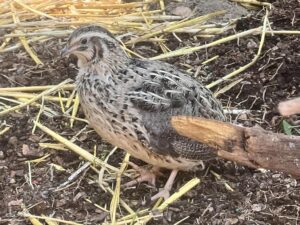
Raising Coturnix Quail on the Homestead: Small Birds, Big Benefits
When most people think about backyard poultry, chickens come to mind. But for homesteaders looking to maximize productivity in small spaces, Coturnix quail might just be the unsung heroes of the homestead. These tiny birds are quiet, fast-growing, and surprisingly prolific, making them ideal for anyone seeking a sustainable source of eggs and meat—even in limited space.
Here’s everything you need to know to raise Coturnix quail with confidence and intention on your homestead.
🐣 Why Coturnix Quail?
Coturnix quail (also known as Japanese quail) are quickly becoming a homesteader favorite—and for good reason:
-
Space-efficient: Thrive in small coops, cages, or stacked colony systems
-
Fast maturity: Begin laying eggs at just 6–8 weeks old
-
High egg production: Up to 300 eggs per hen per year
-
Quiet and discreet: Ideal for urban or suburban homesteads
-
Dual-purpose: Excellent for both eggs and meat
-
Easy to breed and incubate: Hatch in just 17–18 days
In short, they’re the perfect micro-livestock for homesteaders focused on sustainability and self-sufficiency.
🏡 Housing Your Quail
Coturnix quail don’t roost or nest like chickens—they’re ground dwellers with very different needs.
Basic housing requirements:
-
Enclosed cage or pen: 1 square foot per bird is ideal
-
Low ceilings (10–12”) to prevent injury from sudden flying
-
Wire or solid flooring: Wire is easier to clean but harder on feet; add trays or resting boards for comfort
-
Predator-proofing is essential—even small mammals can wipe out a quail flock
Options for homesteaders:
-
Stackable cages in a shed or garage
-
Modified rabbit hutches
-
Secure outdoor aviaries (with netting on top)
Tip: Provide dust bathing areas (sand + ash or dry dirt) and shelter from direct wind or sun.
🥚 Feeding and Watering
Quail need a high-protein diet to stay healthy and productive.
-
Protein content: 24–28% protein for chicks, 18–20% for adults
-
Feed type: Game bird or turkey starter feed works well
-
Supplements: Grit and calcium (crushed oyster shell) if feeding scraps
-
Waterers: Use quail-specific drinkers or low trays with marbles to prevent drowning in chicks
Foraging? While quail will nibble greens, they aren’t effective free-rangers like chickens—keep them penned and supplement with fresh garden scraps or grains.
🐥 Breeding and Hatching
Want to expand your flock? Coturnix quail are easy to breed at home.
-
Sex ratio: 1 male per 4–5 females is ideal
-
Incubation time: Just 17–18 days in a tabletop incubator
-
Temperature: 99.5°F with 45% humidity, increasing to 65–70% at lockdown (Day 14)
-
No brooding instinct: Coturnix almost never go broody—you’ll need an incubator
Brooding chicks:
-
Keep at 95°F for the first week, reducing by 5°F weekly
-
Use a brooder with fine mesh flooring or paper towels to prevent splay leg
-
Feed chick starter and provide shallow water with pebbles or marbles
🍗 Meat Production
Coturnix quail reach butchering size fast—just 6–8 weeks—and each bird yields around 4–6 ounces of clean meat.
-
Extremely tender and flavorful
-
Clean processing with minimal tools (scissors and a sharp knife)
-
Perfect for freezing, grilling, or smoking
For homesteaders, a small rotating group of meat birds means consistent, manageable harvests without overwhelming storage or processing needs.
🧺 Egg Collection and Use
Quail eggs are tiny (about 5 make one chicken egg), but incredibly nutrient-dense and rich in flavor.
-
Harvest daily—quail don’t use nests; eggs are laid randomly
-
Wash and refrigerate or water glass for long-term storage
-
Great for pickling, baking, appetizers, and barter!
Quail eggs are also a popular product at farmers’ markets and among chefs—another potential income stream for your homestead.
🐾 Challenges and Considerations
While Coturnix quail are low-maintenance, they come with a few caveats:
-
Fragility: Handle gently—especially chicks
-
Predation: Secure housing is critical
-
Escape artists: These birds are quick and flighty—always close doors behind you
-
Waste management: Quail poop adds up fast; keep trays clean or use for composting
🌱 Final Thoughts: Tiny Birds, Big Impact
Raising Coturnix quail is a practical, productive, and often overlooked option for modern homesteaders. Whether you’re in a suburban backyard or a full-scale rural homestead, these birds can bring consistent protein, compact meat production, and year-round eggs with minimal investment.
They may be small, but don’t underestimate what a well-managed quail flock can do for your self-sufficiency goals.
Breeding Coturnix Quail: Click Here
